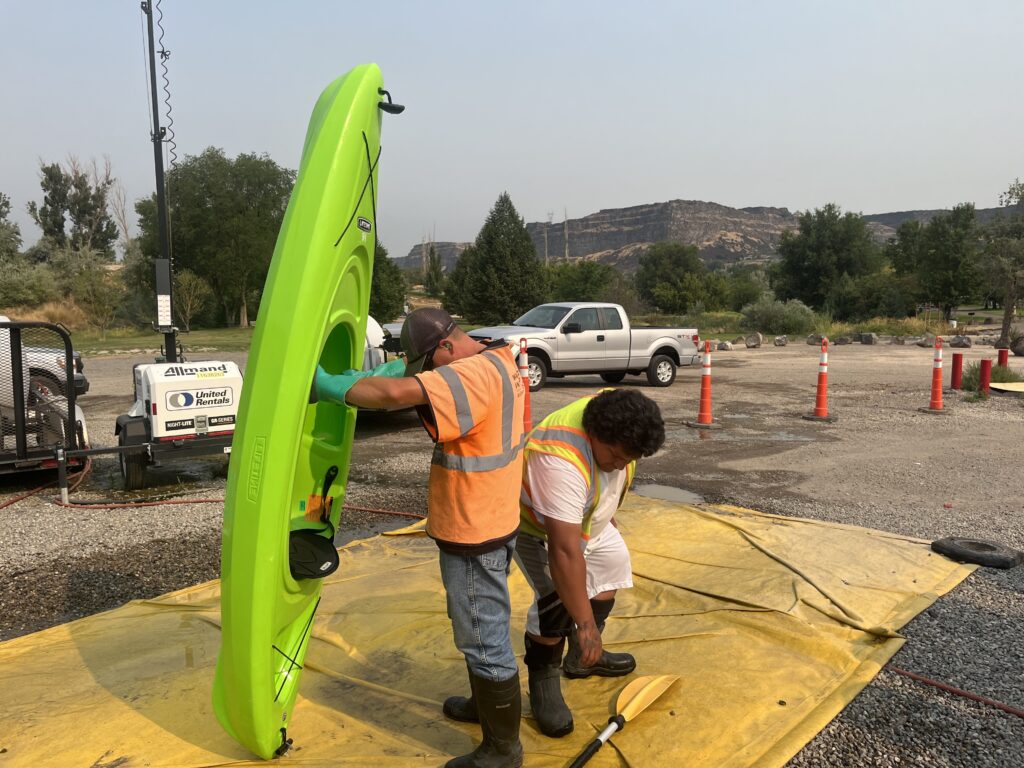Watercraft inspectors Ron Lang (left) and Fabian Rendon, clean and dry a kayak at Centennial Waterfront Park in Twin Falls on Aug. 8, 2024. (Clark Corbin/Idaho Capital Sun)
State officials have not detected viable quagga mussels since resuming water sampling this spring, Idaho State Department of Agriculture Director Chanel Tewalt said.
On Sept. 19, 2023, the Idaho State Department of Agriculture announced it discovered invasive, nonnative quagga mussel larvae in water samples taken from the Snake River near Shoshone Falls and Centennial Waterfront Park in Twin Falls.
State officials administered a copper-based chemical called Natrix to kill the mussels along a 16-mile stretch of the Snake River from Oct. 3 to Oct. 13, the Idaho Capital Sun previously reported.
But state officials had to wait through winter and spring for water temperatures to warm up enough to resume sampling and learn if they killed the mussels and stopped the outbreak.
“We have not had any detections of viable mussels,” Tewalt said in a phone interview. “But we know from data in other states and experiences in other states that we need to sample during what would be the peak reproduction season that we are in now.”
The mussels are capable of reproducing quickly, covering boat hulls, clogging pipes and pose a threat to drinking water, agriculture, recreational tourism and energy generation, state officials have said.
New watercraft rules
As part of the effort to fight the mussels, the Department of Agriculture has expanded its water sampling program and increased the number of watercraft inspection and decontamination stations using two new positions and $6.6 million in funding approved by the Idaho Legislature earlier this year.
As of Monday afternoon, the state has conducted more than 115,000 watercraft inspections, according to the Idaho State Department of Agriculture.
There are also new rules in place this year for watercraft inspection. First, all out-of-state watercraft must be inspected and decontaminated at a watercraft inspection station before entering Idaho waters, according to the Idaho State Department of Agriculture.
Second, for the Snake River between Broken Bridge and Pillar Falls, all watercraft and conveyance (like waders, wading boots or lifejackets) are required to be decontaminated before entering the water and after exiting the water in that section of the river.
To decontaminate watercraft, the technicians at watercraft inspection stations provide hot washes where they spray the boats down, clean them and dry them for free, said Nic Zurfluh, invasive species bureau chief for the Idaho Department of Agriculture.
The state’s overall message is “clean, drain and dry,” and officials are encouraging boaters and recreation users to embrace the program as a way to protect Idaho waters from the invasive mussels and extend the life of their boats.
Zurfluh said the “clean, drain and dry” strategy is something all boaters can do on their own to help, even if they are not required to visit an inspection/decontamination station.
“If a boater is able to clean their equipment – removing all aquatic plants, sediment, mud, that kind of thing – get it all cleaned off, drain all their compartments, pulling boat plugs… making sure to drain any raw water out and then allowing the boat to thoroughly dry between outings, that becomes very important, especially when they’re moving between water bodies or watersheds, different river systems, (and) moving long distances,” Zurfluh said in an interview at the Centennial Waterfront Park inspection/decontamination station. “And it’s not just quagga mussels (we’re trying to stop). There’s other aquatic invasive species, other fish pathogens, that we’re concerned with.”
Zurfluh said the watercraft inspection and decontamination are an important part of stopping the spread of mussels. So far this year, he said state inspection stations have discovered 17 mussel-fouled boats before they got on the water in Idaho. But Zurfluh said state officials now know the response to quagga mussels is a marathon, not a sprint, when it comes to monitoring the health of the Snake River and fighting invasive species.
“We’re getting more efficient with our inspection/decontamination process down here at Centennial Park, but it will take several years of extensive monitoring before we will know with confidence … whether the treatment was effective or there’s additional treatment needed,” Zurfluh said.
GET THE MORNING HEADLINES DELIVERED TO YOUR INBOX
Idaho Capital Sun, like Oregon Capital Chronicle, is part of States Newsroom, a nonprofit news network supported by grants and a coalition of donors as a 501c(3) public charity. Idaho Capital Sun maintains editorial independence. Contact Editor Christina Lords for questions: info@idahocapitalsun.com. Follow Idaho Capital Sun on Facebook and X.

